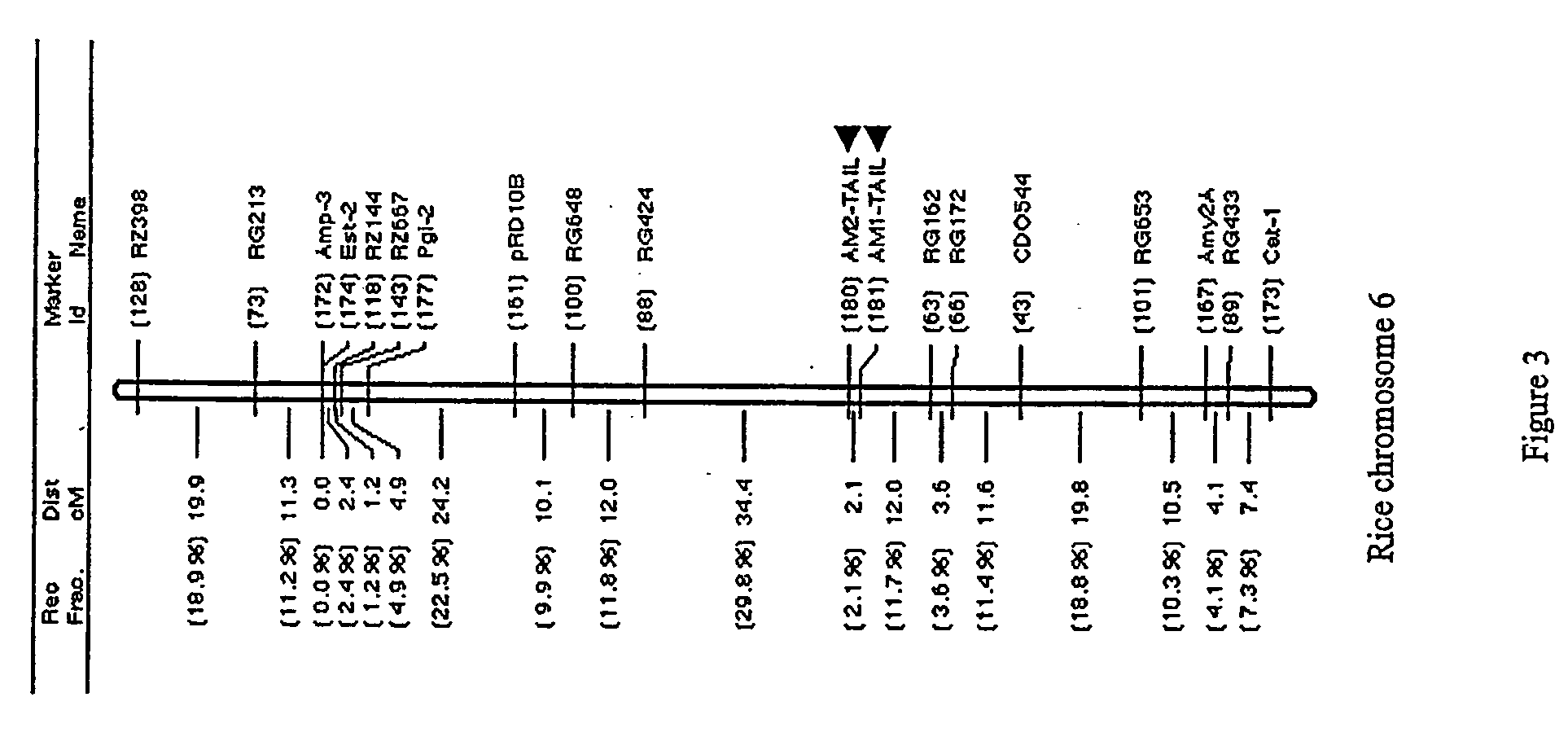Nucleic acids from rice conferring resistance to bacterial blight disease caused by xanthomonas spp
a technology of xanthomonas spp and nucleic acids, which is applied in the field of plant molecular biology and genetics to confer resistance to bacterial disease in plants, and can solve the problems of global crop loss and other problems
- Summary
- Abstract
- Description
- Claims
- Application Information
AI Technical Summary
Benefits of technology
Problems solved by technology
Method used
Image
Examples
example 1
[0060] Disease Resistance Gene Xa3l Conferring Adult resistance to Multiple Xoo Strains
[0061] Since the BC2 progeny containing the Xa3l gene was the interspecific hybrids of O. sativa cv JR3191745-3-2 and O. minuta Acc. 101141 (Amante-Bordeos et al. 1992), repeated backcrossing was used to remove the undesirable traits from wild rice. A highly resistant plant with less undesirable agronomic traits was selected from the cross between 78-1-5BC2F3 #169 and IR24 as pollen donor to cross with susceptible cultivar CO39 at University of California at Davis (unpublished result). Probably due to other genetic factors present in CO39 or other two cultivars (IR3 1917-45-3-2 and IR24) used in the previous backcrosses that interfere with Xa3l, there was a great variation in disease resistance in the progeny from the cross. To simplify the genetic background of the Xa3l germplasm, we selected a resistant F3 plant from the progeny as male to backcross with concurrent susceptible cultivars IR24 an...
example 2
[0065] Identification of Molecular Markers Linked to Xa3l Locus and Genetic Mapping
[0066] Both RAPD (Williams et al. 1990) and AFLP (Vos et al. 1995) techniques were used to screen for Xa3l-linked markers. To detect more polymorphism in both BSA and individual screen of RAPD products, we added [33P-α]dCTP to the PCR mix for labeling RAPD products and separated the RAPD products in a 4.5% polyacrylamide sequencing gel. About 20-50 bands ranging in size from 100 bp to 1500 bp could be detected for each primer. In total, 1200 random primers (Operon Technologies) were screened, and 144 primers were found to detect polymorphism between resistant and susceptible pool, However, after confirmation of RAPD products with individual DNA samples, only random primer BE05 was found to reproducibly detect a polymorphic band between resistant and susceptible individuals (data not shown). The polymorphic band, designated as RM2, is a resistant allele-associated polymorphic DNA. For some unknown rea...
example 3
[0069] Integration of AM1-TAIL and AM2-TAIL into the Rice Linkage Map
[0070] AM1-TAIL and AM2-TAIL were used to map Xa3l on the rice linkage map. For this purpose, genomic DNA from the two parents (IR64 and Azucena) of the DH mapping population (Huang et al. 1994) was digested by 30 different restriction enzymes and blotted for parental survey of polymorphism using AM1-TAIL and AM2-TAIL as RFLP probes. Both the markers showed detectable polymorphism for at least one of the 30 restriction enzymes tested. The two markers were roughly mapped on the long arm of rice chromosome 6 between marker RG424 and RG162 with AM1-TAIL as the distal marker and AM2-TAIL as the proximal marker (FIG. 3). The genetic distance between AM1-TAIL and AM2-TAIL was 2.1 cM (FIG. 3), which was comparable to 1.28 cM (0.31 cM+0.97 cM) obtained from the Xa3l genetic mapping population (FIG. 4B). The genetic distance between RG424 and AM2-TAIL was 34.4 cM and it was 12.0 cM between AM1-TAIL and RG162 (FIG. 3). The ...
PUM
| Property | Measurement | Unit |
|---|---|---|
| Length | aaaaa | aaaaa |
| Length | aaaaa | aaaaa |
| Length | aaaaa | aaaaa |
Abstract
Description
Claims
Application Information
 Login to View More
Login to View More - R&D
- Intellectual Property
- Life Sciences
- Materials
- Tech Scout
- Unparalleled Data Quality
- Higher Quality Content
- 60% Fewer Hallucinations
Browse by: Latest US Patents, China's latest patents, Technical Efficacy Thesaurus, Application Domain, Technology Topic, Popular Technical Reports.
© 2025 PatSnap. All rights reserved.Legal|Privacy policy|Modern Slavery Act Transparency Statement|Sitemap|About US| Contact US: help@patsnap.com



